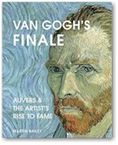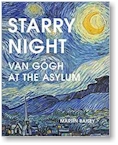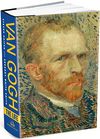


In a recent interview Martin Bailey was asked a question that's been put to him many times before: after all these years are there still new things to discover about Vincent van Gogh? Martin Bailey's hugely successful Van Gogh books answer that question with a resounding yes.
Over the years I've developed certain expectations when reading a Martin Bailey book. One of these is his ability to unearth new insights into an artist dead for more than 130 years, thanks largely to his tireless research. Van Gogh's Finale, like Bailey's other books, doesn't disappoint. There were a number of photographs that I'd never seen before: an 1868 print of a birds-eye view of Auvers-sur-Oise, for example (p. 27) and a 1947 photograph of Vincent Willem van Gogh (Vincent's nephew) at the Tate Gallery in London (p. 198). In addition in a number of cases new provenance details for Van Gogh's paintings were given. As a cataloguer of Van Gogh's works for more than 25 years now, this was especially appreciated. Also, for those interested in making a pilgrimage to Auvers, Martin Bailey provides valuable information about the specific locations--many of which remain largely unchanged to this day.
Van Gogh's Finale is a thorough and engaging overview of the last two months in the life of Vincent van Gogh. The scope of the book is far reaching, but Martin Bailey does focus on two pivotal aspects of that brief time: the role of Doctor Gachet in Van Gogh's life and the divisive topic as to whether Van Gogh's death was by suicide or not.
Personally, I've always held a very critical take on Doctor Paul Gachet. A homeopathic physician (that in itself doesn't instill confidence, but that's easy enough to say well into the 21st century), Doctor Gachet spent time getting to know Van Gogh and was an admirer of his work. Bailey's research into Doctor Gachet actually made me a bit more sympathetic toward the doctor (which surprised me). Perhaps my prejudices against Doctor Gachet weren't entirely well deserved. Still, I've always perceived Gachet as eccentric at best, incompetent at worst. Van Gogh spent a year in the asylum at Saint-Rémy and yet after a mere two months in Doctor Gachet's sphere he commits suicide. I've also thought of Gachet somewhat as an opportunist. Martin Bailey points out that Doctor Gachet eventually owned 26 Van Gogh paintings, most of which can now be found at the Musée d'Orsay in Paris. Clearly Doctor Gachet was a true devotee of Vincent van Gogh's works. And yet one can't but help but wonder why Gachet didn't purchase any artworks from Van Gogh directly. The sale of a painting during a time of emotional upheaval for Van Gogh might have made all the difference.
Another topic thoroughly covered in Van Gogh's Finale is the debate about the circumstances surrounding Van Gogh's death. In 2011 Steven Naifeh and Gregory White Smith published their book Van Gogh: The Life (see below). This extremely well received book drew a great deal of attention with its theory that Vincent van Gogh didn't commit suicide, but rather was shot--possibly by accident. There has been a great deal of debate over the last decade and Martin Bailey approaches the topic with great insight. Bailey explores the various facets of the murder theory and dismantles them one by one. His research and analysis are both illuminating and persuasive. Martin Bailey's thorough exploration of the topic should put the argument to rest--at least for now.
Finally, I'd be remiss not to mention the wonderful and visually engaging layout of Van Gogh's Finale itself. The book is filled with interesting photographs and the very best quality images of Van Gogh's beautiful artworks. It's a feast for the eyes. Martin Bailey is one of the best regarded specialists of Vincent van Gogh in the world and the superb quality of his books always delivers.

After nearly 130 years one might assume that the different artistic periods in Van Gogh's life have been fully covered. Martin Bailey shows yet again that diligent research can uncover new treasures. Studio of the South sheds light on many aspects of Van Gogh's time in Arles that have been otherwise overlooked or misunderstood. Martin Bailey, no armchair scholar, accessed archives and historical records previously unseen. The result is a rich tapestry of historical information about Van Gogh's time in Arles. Also included is the artist's stay in Saintes-Maries-de-la-Mer where he produced some of his most remarkable landscapes and seascapes.
Studio of the South is lavishly illustrated with the finest reproductions. This is enough to recommend the book, but Martin Bailey also includes a number of illustrations never before published. Some came as a real surprise to me. Still Life: Majolica Jug with Wildflowers which dates from May, 1888 actually has a red border on three sides (not the bottom), a flourish completely unprecedented in his oeuvre. Bailey's book illustrates this work properly for the first time.
Martin Bailey's writing is, as usual, clear and engaging. He frequently turns to Van Gogh's letters (the newer 2009 translation, of course) as a base for his explorations. The result is a beautifully researched and wonderfully illustrated jewel in the field of Van Gogh studies.

"So many people come to me and say there isn't any more to discover about Van Gogh, but of course there is. There always is."
Starry Night: Van Gogh at the Asylum is an in depth exploration of the year that Vincent van Gogh voluntarily committed himself to the Saint-Paul-de-Mausole facility in Saint-Rémy, France in May, 1889. While it's true that many Van Gogh biographies thoroughly explore Van Gogh's time at the asylum, Martin Bailey's book charts new territory and the result is extremely satisfying.
I was pleased that Martin Bailey spends relatively little time discussing what was "wrong" with Van Gogh? Epilepsy? Manic depression? Bad genes? A combination thereof? None of the above? The truth is we'll never know for sure so that well trodden ground is wisely bypassed. Instead Martin Bailey offers a deep and involved investigation into Van Gogh's life at the asylum. He paints a detailed (and often depressing) picture of Van Gogh's time at Saint-Paul-de-Mausole. More than any other author before him, Martin Bailey's research breathes fresh insight into this crucial period in the artist's life.
Starry Night uncovers some valuable facts about Van Gogh's stay at the asylum. Information about the patients and the staff caring for them. Martin Bailey's research unearthed some interesting new discoveries. For example, until now the identity of the subject in Van Gogh's painting Portrait of a Young Peasant was unknown. But Martin Bailey discovered not only the name of the man (Jean Barral), but also detailed background information about him as well.
Additionally, one of the great pleasures of Starry Night is the wonderful reproductions of Van Gogh's art works. There are no better and more striking images anywhere. And Martin Bailey comments on these works in great depth--often pointing out subtle but fascinating details that I hadn't noticed even after a hundred previous viewings.
In all my own Van Gogh travels over the years I have yet to visit the hospital in Saint-Rémy. Martin Bailey's Starry Night: Van Gogh at the Asylum is the next best thing.

I'm chagrined that it's taken me nearly a year to write a proper review of Steven Naifeh and Gregory White Smith's monumental new biography of Vincent van Gogh. In my own poor defense a number of Van Gogh-related projects (which brought me to Amsterdam twice in 2012) were an ongoing (but pleasant) distraction. More to the point, this biography was not something I wanted to rush through. A few early (and, not surprisingly, hugely positive) reviews came out just days after the book's publication. "How is it possible," I wondered, "to properly read and evaluate such an incredible resource so quickly?" Which is not to slight any of the early reviewers, of course. In addition, I found the wonderful online notes for the biography (www.vangoghbiography.com) to be an endless (and quite marvelous) diversion. I was forever running between book and computer to delve into further detail of yet another new and insightful fact that was a revelation to me.
Steven Naifeh and Gregory White Smith have written the authoritative biography of Vincent van Gogh. The Van Gogh Museum in Amsterdam calls Van Gogh: The Life "The definitive biography for decades to come." The Wall Street Journal describes it as "captivating." High praise and more than well deserved.
I admire many of the earlier biographies, but the Naifeh/Smith work stands out as the leading and only Van Gogh biography for Van Gogh scholars and enthusiasts alike. The book took more than ten years to write and research and yet, in a work of this vast scope, one could easily assume that the effort spanned twenty or thirty years.
Van Gogh: The Life is an absolutely remarkable exploration of Vincent van Gogh and his work. The material, as I've mentioned, has been covered before, but never so thoroughly and with such thoughtful attention to detail. Naifeh and Smith turn old myths and fallacies inside out and present the life of Van Gogh in an entirely new and remarkable light.
I have an entire shelf of Van Gogh biographies and know the subject well. Or at least I thought that I did. I can honestly say that while reading Van Gogh: The Life nearly every page brought forth new revelations and surprises. A work this beautifully researched is bound to enter "uncharted territory," and this biography is absolutely outstanding in its scope, attention to detail, scholarly diligence and insight. I can honestly say that, for the first time ever, I actually felt that I was reading about a living, breathing, deeply flawed and entirely exceptional human being.
In addition, many of the past Van Gogh biographies (and Van Gogh references in general) can suffer from a certainly dryness of style. Van Gogh: The Life, however, is immediately engaging in its approach. It's a rare feat for a biographical work of this depth to be ceaselessly entertaining as it also explores its subject matter in minute and brilliant detail.
In the end Van Gogh: The Life by Steven Naifeh and Gregory White Smith is an absolutely extraordinary and astonishing book. Without question, this is the most superb Van Gogh biography ever written--indeed, one of the best written biographies ever published.
| I list several Van Gogh biographies below. All interesting and worthy works in their own right, but there's no question that the first stop for anyone interested in the life of Vincent van Gogh should be the Steven Naifeh and Gregory White Smith biography, Van Gogh: The Life above. |
Fictional Biographies
The book falters from time to time, particularly with the sexual references which seem out of place and contrived. Johanna's final resignation to Vincent is also a bit disappointing. But an excellent exploration, nonetheless, of the admirable life of Johanna van Gogh-Bonger.
Of Particular Interest . . . .
 Return to Van Gogh Books page
Return to Van Gogh Books page
 Return to main Van Gogh Gallery page
Return to main Van Gogh Gallery page